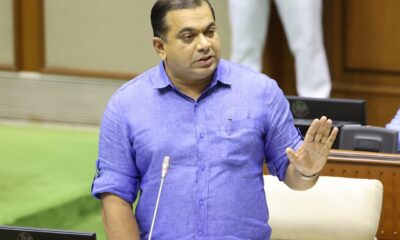Published
1 year agoon
By
goaplusnews
Panaji : The Forest Department has begun beautifying major routes with colourful, ornamental plants as well as foxtail and Veitchia merrillii palms, ahead of the G20 meetings, to create a picturesque view.
The Department is crafting a spectacular makeover of the capital ciyt’s major routes with a palette of vivid colours and an array of ornamental foliage and palms. The aim is to turn the dividers and roads into a lush green paradise, ready to welcome the G20 meetings in grand style with Chief Minister Pramod Sawant personally monitoring every bit of the preparedness.
This initiative is aimed at creating a greener and more visually appealing environment ahead of the G20 meetings scheduled to take place in Goa from April 17.
“The plan is to plant ornamental and flowering plants along the medians and roadsides of various stretches. The first phase of the project will include routes from Mercês to KTC bus stand in Panjim, GMC in Bambolim to NIO in Dona Paula, Verna to Dabolim Airport, and Mercês Circle to Old Goa. The Forest Department has carefully chosen ornamental plant species that are not grazed or browsed by stray cattle for the medians of roads to ensure their survival. They have selected a variety of colourful plants and planted 100 foxtail palms at Mercês Circle, creating a beautiful visual impact,” the government said.
The Department has completed planting along a 1.7-kilometer stretch from Chicalim circle to the Dabolim Airport as well as planting at the traffic triangle at the Verna signal as well as the road from Verna junction to airport.
The suggested plants for road medians include Nerium, Tecoma (Orange and Rosea), Jatropha, Ficus, Veitchia merrillii palms, and Bougainvillea. While the islands and triangles feature lawn, topiary plant models, Golden pandanus, Kodia, Rasoliya, Tecoma, and Loropetalum burgundy.
These plants are selected for their aesthetic appeal and low maintenance requirements, and they aim to enhance the beauty of the surroundings and provide a pleasant environment for motorists and pedestrians. The department has also planted plants such as lagerstroemia speciosa (Pride of India), Peltoforum (yellow flamboyant), Cassia Fistula (Golden shower), Jacaranda mimosifolia (Nil mohar), Spathodea (African tulip tree), Bahunia blakeana among others, along the 8-kilometre stretch from Merces circle to Old Goa.
In addition to the median plantation, topiary plants have been planted outside the Dabolim Airport to create a greener and more attractive environment. However, lawns will only be planted in selected areas, such as the Verna traffic triangle, Bogmalo junction, and spaces near Dabolim Airport to cover ground surfaces. Planting saplings during the summer season is a challenging task due to the high temperatures and lack of rain, which make it difficult to maintain the plants.
However, the Forest Department is working closely with the Public Works Department (PWD) to ensure that the plants are watered at least twice a day.
Vishal Surve, Deputy Conservator of Forest, says that “the watering part is looked after by the PWD. Planting in the month of March/April is difficult as we are in the summer season. We are closely working with the PWD department to get these saplings watered at least twice a day.”
The Forest Department plans to plant nearly 10,000 flowering and ornamental plants from Mercês Circle to Old Goa and the City area, with over 20,000 saplings used in median and roadside plantations. The plants, including foxtail palms have been sourced from private nurseries in Pune, Maharashtra and Rajahmundry in Andhra Pradesh.
“Adding landscaping and greenery can enhance the value of any place, and we have taken great care in selecting plants that are well-suited to the climate in Goa. We have also made significant improvements to the medians and traffic islands to accommodate the G20,” says Sanjit Rodrigues, Nodal Officer(G20).
The median and roadside plantation project is expected to give a new and greener look to the dividers and roads in Goa. The project is part of the state’s efforts to create a more sustainable and eco-friendly environment, which is in line with the goals of the G20 meetings that will be taking place in the state.


MLA Sankalp Amonkar Urges Action on Agriculture, Civil Supplies, and Handicrafts in Assembly Demands


CSC Diwas Celebrates 15 Years by Honoring VLE Excellence


MLA Borkar Flags Soaring Unemployment in Goa, Demands Overhaul of Employment Exchange Act


Manipal Hospital Performs Life-changing Restorative Surgery Saves Hand of a resident of Sawantwadi


The all-new BMW CE 04: First premium electric two-wheeler in India.


After Due Repairs, Public Toilets At Vagator will be Functional: TM Khaunte










